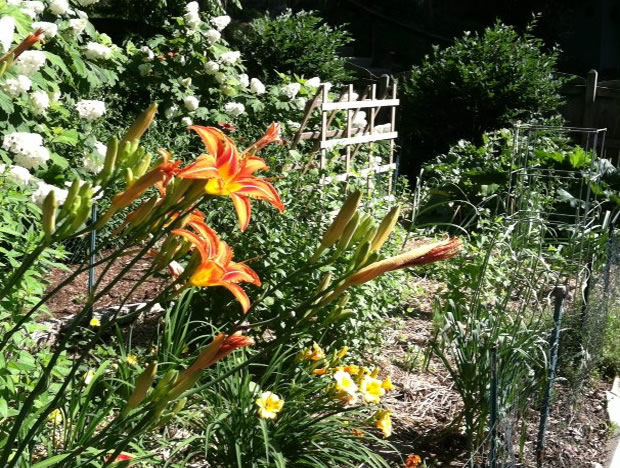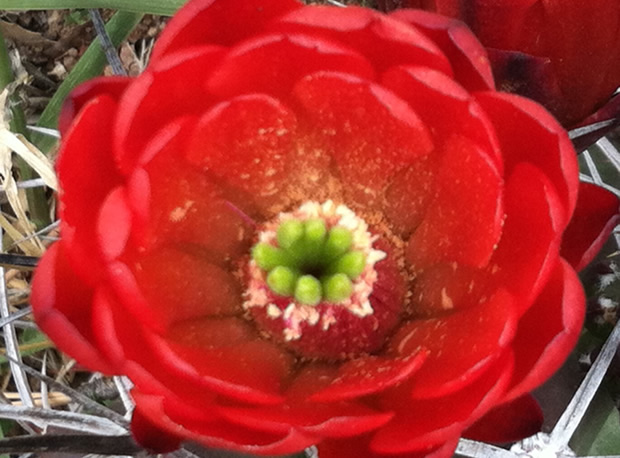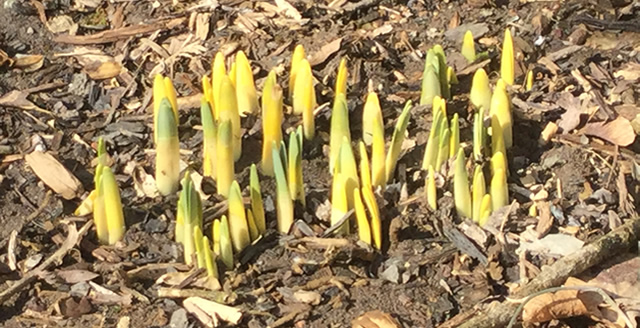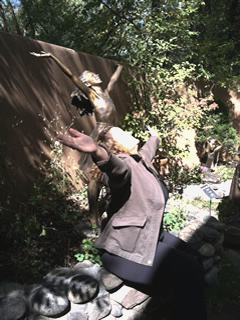
“You can’t really criticize the moon,” one of my Wise Women yoga students observed on the heels of our yoga practice. It was the day before the new moon at its darkest stage, a time in the moon’s cycle connected with the idea of “new beginnings.”
In the days leading up to our class, the idea of “new beginnings” had taken roost in my mind as a dear and close family member struggled to find the best path for herself and her family. When I noticed the small darkened circle in the corner of June 4 on my calendar, I made the connection – new moon, new beginnings. I did a little research on the symbolism attached to the new moon only to find the idea of “new beginnings” coming up again and again.
The new moon is a time of both darkness and a sliver of light, which, like the gentle light of winter, supports a more internal focus, encouraging reflection. We can look at old goals, some of which may have been laid aside or forgotten as other aspects of our lives required more attention.
As I started reflecting on my old goals, I became aware of a new beginning I made in my practice of vedic chant. Although I had been studying and practicing chanting since 2003, my progress had been slow and disappointing. About a year ago, that changed when I decided to work via Skype every two or three weeks with a chant teacher. My chanting practice became more regular. I felt a renewed commitment to continue, and not only saw progress, but came to enjoy the work, as well. Sometimes the new beginning simply requires a new direction to move us closer to our objective.
As we reflect, we might decide to resurrect and recommit to some old goals. Some may have already been attained. With others we may find new directions reveal themselves. Some goals might have beginning after beginning in an ebb and flow, each one leading down a path we hadn’t expected when we first began. But not all old goals may seem as desirable as we had initially thought, and those we may decide to release. .
With the darkness and sliver of light of the new moon encouraging reflection, we each might ask ourselves what it is we might want to cultivate in our lives. Courage? Compassion? Joy? Patience? Balance? Or perhaps there is something more concrete we would like to attain. A daily yoga practice? Traveling? Playing the piano? Volunteering to read to children? Finding a different job?
We need only be open and patient to what may come up in our reflections, be not afraid to plot a path toward what we hope to cultivate, and move with patience and a willingness to continue to listen to ourselves and be open to modifying our direction.
The new moon days invite us to make new beginnings.
~
Below is a poem by a favorite poet of mine, inspired by the new moon.
How much it must bear on its back,
a great ball of blue shadow,
yet somehow it shines, keeps up
an appearance. For hours tonight,
I walked beneath it, learning.
I want to be better at carrying sorrow.
If my face is a mask, formed over
the shadows that fill me
may I smile on the world like the moon.
…Ted Kooser
Choosing Peace, 2016
 With the bluster of loud voices swirling in the public space and spewing divisiveness, bigotry, and violence, it is no wonder anyone of us might be feeling anxiety, or even a sense of powerlessness. The news has a certain seductive quality, and our minds react with a desire to know “what is happening,” “who is saying what,” and “how ordinary people are responding.” The irony is that as we are drawn into feeding this desire to know, we are feeding our anxiety and our sense that things are out of control. I know. I have been there.
With the bluster of loud voices swirling in the public space and spewing divisiveness, bigotry, and violence, it is no wonder anyone of us might be feeling anxiety, or even a sense of powerlessness. The news has a certain seductive quality, and our minds react with a desire to know “what is happening,” “who is saying what,” and “how ordinary people are responding.” The irony is that as we are drawn into feeding this desire to know, we are feeding our anxiety and our sense that things are out of control. I know. I have been there.
Most of us do not want to live with the whirling thoughts and energy that this type of activity generates in our systems. So how do we live in the world and still have peaceful minds
and hearts?
Patanjali, in Yoga Sutra II.33 speaks to the state of mental and emotional distress, doubt, confusion, and agitation that emerges when our bodies and minds are overloaded with troubling news and images. He tells us very simply: When harassed by doubt, cultivate the opposite mental attitude. In other words, give up immersing ourselves in what is causing our confusion, distress, and anxiety. Instead, take steps to cultivate what helps us to have a peaceful mind and heart.
To quiet the mind and body we have the 8 – limbs of yoga, which include the practices of yoga postures and breathing techniques. For me, most recently, as an antidote to the disturbing public discourse, I have focused on the ethical principle called ahimsa. Ahimsa is one of five ethical principles, called yama. The yama is the first limb of the eight-limbed path of yoga and its principles are to guide us in our all our relationships and with the world around us: non-violence (ahimsa), truthfulness (satya), non-stealing (asteya), moderation (brahmacarya), and non-covetousness (aparigraha).
Ahimsa is considered the most important of the yama and can also be translated as “respect for life” or “abstaining from harm” and implies cultivating an attitude of benevolence and care. So what does the practice of ahimsa look like in our lives?
To start, ahimsa requires us to examine our attitudes and behaviors toward ourselves. Do we treat our bodies, minds, and emotions with an attitude of respect? We can ask ourselves if we are making compassionate choices about our exercise, our yoga practice, our diet, our rest, the TV, media, or films we expose ourselves to, even the relationships we choose to have in our lives. Do we bring harm to our bodies by running in spite of an injured knee or regularly eat fast foods? Do we practice yoga in a way that leaves us breathless or fatigued? Do we watch TV shows or movies where we are exposed to hateful messages or violence? Are we in relationships where we are not respected?
This can be our first step toward practicing an attitude of ahimsa – becoming aware of our attitudes and behaviors toward ourselves and moving away from those which are harmful and toward those which are kind, respectful, and caring. Our self-study can then focus on how we speak and behave toward others, looking at our thoughts, our speech, and our behavior in our relationships with the same kind of questions that we asked about our attitudes toward ourselves.
In the current atmosphere of dissension, intolerance and tension in our country, the practice of ahimsa gives me hope, not just for our own behavior, but also for that of others. Patanjali tells us that when a person is firmly established in living ahimsa with respect for all beings, those who have aggressive impulses or behavior are calmed in his presence.
As more of us come to consciously cultivate ahimsa, perhaps we can act as instruments of peace in the troubled times in which we live, rather than as victims of public animosity.
The Dilemma of Desire

I have been thinking about trading in my old iphone 4 for a shiny new iphone 6. Some days when I sit staring at my phone, waiting for my email, or a news article, or a Facebook page to appear on the screen of my old phone, I imagine the ease a new phone might bring to my life. Emails arrive promptly; photos appear sharp and clear, and my searches materialize without glitches.
Patanjali’s Yoga Sutra tells us that most human beings suffer from afflictions – called klesas – that cause distress and suffering. You may be surprised to know that the main affliction, called avidya, is misapprehension, lack of understanding, or ignorance: we think we know something and we don’t, or we think we don’t know something and we do. This avidya manifests in our attitudes, relationships, and actions causing problems.
One of avidya‘s “children” is raga, which is best translated as a burning desire, attraction, or attachment to something. We have experienced a pleasant situation, and we want to repeat it again, and again, and again. In its most intense manifestation, raga is addiction.
Even today as I sat down to write, I kept thinking about making myself a nice cup of coffee with some foamy milk and stevia. For me, this kind of coffee has pleasant associations beyond the drink – things like sitting at a table under a palm tree outside a coffee shop on a sunny day in Los Angeles talking with my daughter, or sitting with my husband at Wegman’s enjoying a late afternoon coffee and muffin, or coming to my desk with my coffee and writing without hesitation something important for me to express.
Too much coffee has a down side for me, as well, causing heartburn and stomach discomfort, and, if caffeinated, leaving me feeling a little jittery and unable to focus. To think that the cup of coffee will leave me with only the pleasant feelings I have experienced in the past is avidya.
Patanjali calls avidya a confusion, mistaking “the ephemeral for the eternal, the impure for the pure, suffering for pleasure, the trivial for the essential” (YS II.5 as translated by Frans Moors in Liberating Isolation). This confusion is a source of suffering.
There is nothing wrong with buying an iphone 6 or having a cup of coffee with foamy milk. Suffering occurs when we obsess about having the phone or coffee, as if our ability to feel contentment depended upon having one or both. Or, on the other hand, we are so caught up by desire that we fail to see or acknowledge the possible negative effects the acquisition might bring.
To avoid the suffering that arises when raga becomes active requires noticing when the desire or attachments begin to appear. Then we can come to our yoga mat and practice, creating space so we have some distance or detachment from the object of our desire. That space can allow us to reflect on possible causes for the obsession, such as poor diet, lack of rest, or stress, as well as possible consequences. With an appropriate yoga practice we have the tools we need to come back to balance.
This week just begin to notice if raga may be coming up in your life.
A Question of Balance


The other morning, as the heat and humidity rose, I puzzled over the best place to plant my dill, tarragon, rosemary, cilantro, marigolds and zinnias. Our garden is in a bit of disorder, with garlic still maturing to harvest, lusciously overgrown rhubarb, large tufts of catmint, peppermint, lilies, sundrops, and a couple of tomatoes.
Sweat dripped from my face as I stepped one leg over the two-foot fence guarding our plantings. In my arms were plants, a trowel, and a digger. My focus was on where I would plant everything, and I was getting tired. Looking back, I can see that this was a set up for trouble. Not paying attention as I lifted the other leg over the fence, I was thrown off balance as my pant leg caught on the fence, throwing me to one side where I nearly fell on an overgrown thyme plant.
I was lucky. I was able to recover my balance rather than falling, but it reminded me how vulnerable we become when our attention wanders.
But losing one’s balance can occur in realms beyond a physical fall. Some of you may have heard me speak of the challenges I face when travelling, especially when I am away several weeks. The physical environment is different from where I live. The food and water I consume is new. My sleep and activities change, and I often feel on sensory overload. I may have enjoyed the time away, but I feel the imbalance in different parts of my system when I return home.
It takes time and patience to return to balance. A friend told me that rebalancing when we come home from a trip takes the same number of days as we were away. From my own experience I believe it.
Many students come to yoga class and tell me they need to improve their balance, meaning physical balance. Yoga talks about a model of the human system called the pancamaya model. This model describes five aspects of the human system: the physical, the energetic, the mental, the personality, and the emotional. They are all interrelated, meaning that an imbalance in any one aspect affects the others.
My fatigue and inattention in my garden the other morning were definitely aggravated by the heat and humidity. But I also have to remember that I am still recovering my balance from three and a half weeks of travel.
I share this with you with the hope you will start observing yourself. What throws you “off balance,” what can you do to reduce the effects, and what do you need to bring you back to balance.
EXPLORING BALANCE
8 week series focusing on balance in body, breath, and mind
Discovery Yoga: Wednesdays, June 17 – August 5, 5:45 – 7:15 pm
Yoga 4 Wise Women: Fridays, June 12 – August 7, 9:00 – 10:30 am
(no class July 10)
TMC, wellness through movement, 2134 N. 2nd, Harrisburg.
For more information, contact me:
eterryyoga@gmail.com or 717-645-0067
Coming Home


I just got off the phone with my dear friend and fellow yoga teacher Lynne Graham. Some of you may remember Lynne from the lovely practices she taught the Yoga for Wise Women class as she was completing her teacher training.
Lynne is one of those people who continues to learn about and delve more and more deeply into the study of yoga. In our conversation, she explained she has come to see problems that arise in life as opportunities to motivate further study of yoga, knowing the philosophy and practices of yoga hold insights and healing for challenges we experience. It is a way to approach positively what might have felt like a large obstacle.
As she labored over planning for a yoga class, Lynne explained, she decided to give up her usual routine of drinking coffee, recognizing that coffee was not helping her, and perhaps making the planning process more difficult.
I understood exactly how unfocused the mind can become after having too much caffeine. Rather than connecting more deeply with the tasks at hand, my mind is on caffeine is like a fly, buzzing here and there, landing briefly, then buzzing off to alight on another thought. Even without caffeine, I have found myself, from time to time, distracted, thinking answers to my problem lie outside myself – in a book, if I find the right page, in notes if I can only find them, in a website – any place other than within me. This kind of search is usually fruitless, just another distraction, really, from focusing on what I need to do.
Breaking from her coffee routine, Lynne decided instead to do some chanting, a breathing practice, and meditation. What she found was that this new approach yielded a focus, a certainty of direction for the class she would be teaching.
Her insight – beyond the immediate planning for her class – was to realize she already had the knowledge she needed. And, the way to access that knowledge was to make space to go within. This is the intention of our yoga practice: letting go of the distractions of the mind. In doing so we can come to see ourselves more clearly. In observing ourselves with greater clarity, we come to know ourselves, which is the goal of yoga.
Our yoga practice, done over time consistently, illuminates a path leading us to look within. It is where we can find answers, as well as peace, and faith. It is a going home.
Thank you, Lynne, for this reminder.
Spring, the Sky…

Spring, the sky rippled with geese,
But the green comes on slowly…”
From “March 16,” in Ted Kooser’s Winter Morning Walks
We have almost arrived at the end of March, and I have been observing its fluctuating energy throughout the month. What have you noticed this month? And, not just about the weather. How has your body been feeling? What has your energy been like? How have your moods been?
It is in the nature of March to reflect both the winter we have barely left and the spring that is promised. And each season has an energy that influences each individual depending upon his or her unique system.
A friend of mine with whom I spoke on one of March’s first sunny, warm days talked about feeling a sense of excitement without knowing why. I thought it funny she expressed it that way as I had been experiencing a similar sense of excitement. It was only when she mentioned this that I began to relate it to what was going on around us.
On a warm sunny early spring day there is a feeling of potential energy. My friend described it as “pregnant energy.” I had just noticed earlier in March how daffodils in my yard had pressed through the cold, hard earth, undeterred by snowfalls. They were growing greener and taller each day. “Pregnant energy” had pushed them toward the sun with a promise of blossoms, energy expressed in their opening. That pregnant energy is an energy of anticipation, excitement, a movement toward birth, renewal, fulfillment.
But even now as the vernal equinox is behind us, we can still feel the fluctuating energy of this season. Ted Kooser expresses this best in a short poem in which he speaks of “The pond, still numb from months of ice,” and juxtaposes it to the nearby “budding maple whose every twig is strung with beads of carved cinnabar, bittersweet red.” On a chilly, overcast March day, one perhaps even offering some wintry precipitation, we may relate more to ice barely cleared on the pond, or, for us living close to the Susquehanna, to ice barely cleared in the river. On such days the excitement of spring is dampened, and we feel a heavier, denser energy of winter not ready to let go to make room for spring.
Transition is often difficult. And the transition between the pregnant potential of a promised spring and weighty, internal energy of winter can bring a sense of agitation, confusion, or maybe even a sense of just being worn down.
One of the teachings of yoga that helps me with the fluctuating days of this seasonal transition is parinama vada, translated as “everything changes.” We learn that everything in the material world is in flux. It is the nature of things to be constantly changing, including ourselves, which we see as we grow from children, to adolescents, to young adults, to middle age, and to elders.
A regular yoga practice attunes us to the changes around us and within us. We learn to live in the present moment and accept that change and transitions are inevitable.
When the moody indecision of March plagues our bodies, energy and dispositions and disappoints our desire for a more consistent diet of pleasantly warm and sun, we can remind ourselves that it will change. That is assured.
Joy
Note: Joy is one of our eleven Benefits of Yoga
 Yoga identifies five dimensions in our human system: the physical or annamaya, the energetic or pranamaya, the intellect or manomaya, the personality or vijnanamaya, and the emotional or anandamaya. The word ananda, in the emotional dimension, is translated as “joy that never stops.” This level of our system is capable of joy because it is not linked to habitual ways of thinking that cause suffering.
Yoga identifies five dimensions in our human system: the physical or annamaya, the energetic or pranamaya, the intellect or manomaya, the personality or vijnanamaya, and the emotional or anandamaya. The word ananda, in the emotional dimension, is translated as “joy that never stops.” This level of our system is capable of joy because it is not linked to habitual ways of thinking that cause suffering.
Habitual patterns of thoughts may be things such as ruminating over regrets about something in the past, or thoughts of failure because we have less than our friends, or fears about our future or our children’s future. When our minds our engaged in these kinds of negative thoughts, we feel constricted, ill at ease: we cannot experience joy.
Since yoga acts on all the different parts of our human system, doing postures, simple breathing techniques, and using sound or other tools of yoga can allow us to see negative patterns of thought and help free us from them and the frustration and unhappiness they engender. Over time, an appropriate, regular yoga practice helps us to see those things creating “non-joy” so we may let go of them, and those things linking us to that joy inherent within us. Through our yoga practice, we can choose to move toward what is positive, toward what nourishes joy at our deepest level.
